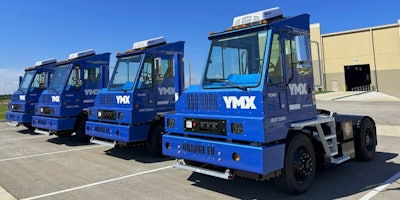
Yard operations run at their best when drivers are properly trained, equipped, and supported to perform their jobs safely and efficiently. Known as yard jockeys, hostlers, or switchers, these essential workers keep trailers moving in and out of docks, enabling the flow of goods through distribution networks. Yet despite their critical role, driver safety in the yard is too often treated as a reactionary measure, only prioritized after a near-miss or injury occurs.
This reactive mindset puts not only individual drivers at risk but also exposes organizations to serious operational disruptions, liability costs, and reputational damage. In high-volume yards, especially those supporting consumer packaged goods (CPG) and manufacturing distribution, any safety lapse can quickly ripple into missed outbound shipments, detention fees, or worse.
Instead, companies should take a proactive and predictive approach. That means embedding safety into every shift and decision through robust training, reliable equipment, and real-time technology. A proactive driver safety program doesn’t just prevent incidents. It builds operational resilience and improves employee satisfaction in the process.
Start with training: Initial and ongoing
At the foundation of every successful yard safety program is structured training. According to the Federal Motor Carrier Safety Administration, carriers that invest in formal driver training programs see safety incidents decrease by as much as 30% in the first six months.
Effective onboarding should go beyond basic procedures. It must reflect site-specific risks and teach drivers to navigate them confidently. A comprehensive program should include:
● Pre- and post-shift truck and trailer inspections.
● Safe docking and undocking procedures.
● Understanding of yard layout, traffic patterns, and signage.
● Maneuvering techniques, especially for tight or high-traffic areas.
● Emergency protocols and escalation procedures.
However, initial training is only the first step. Yard environments are dynamic. Conditions, equipment, and schedules change, and complacency can set in. That’s why the most effective safety programs include continuous reinforcement, such as:
● Monthly or quarterly “Safety Days” focused on hands-on retraining.
● Online refresher modules tailored to seasonal or operational changes.
● Peer-led training sessions that recognize and elevate safe behavior.
When learning becomes routine, safety becomes second nature.
Equip drivers with safe, reliable vehicles
Training means little if the equipment isn’t up to the task. A yard truck that overheats, leaks fluid, or lacks working mirrors undermines the safety of even the most experienced drivers. Unfortunately, many organizations still rely on aging fleets or skip routine preventative maintenance.
Common risks linked to poor equipment maintenance include:
● Increased likelihood of breakdowns or trailer damage during maneuvers.
● Inadequate climate control leading to heat stress or fatigue.
● Excessive diesel emissions contribute to long-term respiratory issues.
Investing in modern, well-maintained equipment isn’t just about compliance. It sends a signal to drivers that their safety and comfort matter. Electric yard trucks, for example, are gaining traction not only for sustainability but also for their quiet operation and reduced exposure to harmful emissions, an important benefit in enclosed or high-volume yard environments.
Leverage technology to identify and prevent risk
The yard truck cab may look familiar from the outside, but its interior is rapidly evolving. With the right technology, companies can detect unsafe behavior, monitor performance, and prevent accidents before they happen.
According to Verizon’s 2024 Fleet Technology Trend Report, operations that use in-cab video systems saw a 73% improvement in safety behavior and a 48% reduction in accident-related costs. Here’s how tech is helping leaders stay ahead of safety risks:
● AI-powered dashcams offer real-time feedback and post-incident analysis.
● Driver behavior sensors detect signs of fatigue or distraction.
● GPS and telematics data highlight high-risk maneuvers and idle patterns.
● Yard management software allows supervisors to spot bottlenecks or near-misses across sites.
The American Trucking Association reports that predictive analytics can reduce accident frequency by up to 22%. But the real power lies in turning insights into action by adjusting training, modifying traffic flow, or establishing new safety protocols based on real data.
Embed safety into the culture
Even with strong processes, the most lasting safety improvements happen when the entire organization, from leadership to frontline drivers, embraces a shared culture of accountability.
Safety shouldn't be treated as a compliance checkbox. It’s part of a broader mission to optimize yard operations by striking the right balance between people, processes, equipment, and technology. That includes site-specific training, standardized playbooks across locations, and a driver-focused approach to operational design.
To create a truly embedded safety culture, consider these steps:
● Recognize safe behavior publicly through awards, incentives, or performance bonuses
● Include drivers in problem-solving efforts related to safety, traffic flow, and SOPs
● Tie safety metrics to performance goals for site leaders and supervisors
● Design feedback loops so drivers can report hazards or suggest improvements without fear of retaliation
Safe yard operations don’t happen by accident
They’re engineered, reinforced, and led. In today’s fast-moving supply chain landscape, where every missed appointment or injury adds up in cost and risk, safety must be seen as a strategic priority, not just a compliance task.
By investing in the right training, equipment, and technology and by creating a culture where drivers feel supported and valued, organizations can turn their yards into safer, more productive environments that drive resilience across the supply chain.


![Pros To Know 2026 [color]](https://img.sdcexec.com/mindful/acbm/workspaces/default/uploads/2025/08/prostoknow-2026-color.mduFvhpgMk.png?auto=format%2Ccompress&bg=fff&fill-color=fff&fit=fill&h=100&q=70&w=100)







![Pros To Know 2026 [color]](https://img.sdcexec.com/mindful/acbm/workspaces/default/uploads/2025/08/prostoknow-2026-color.mduFvhpgMk.png?ar=16%3A9&auto=format%2Ccompress&bg=fff&fill-color=fff&fit=fill&h=135&q=70&w=240)





